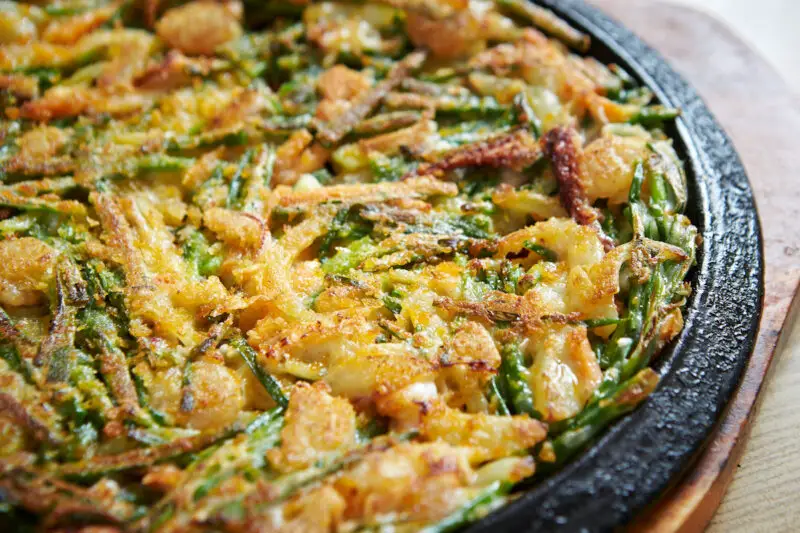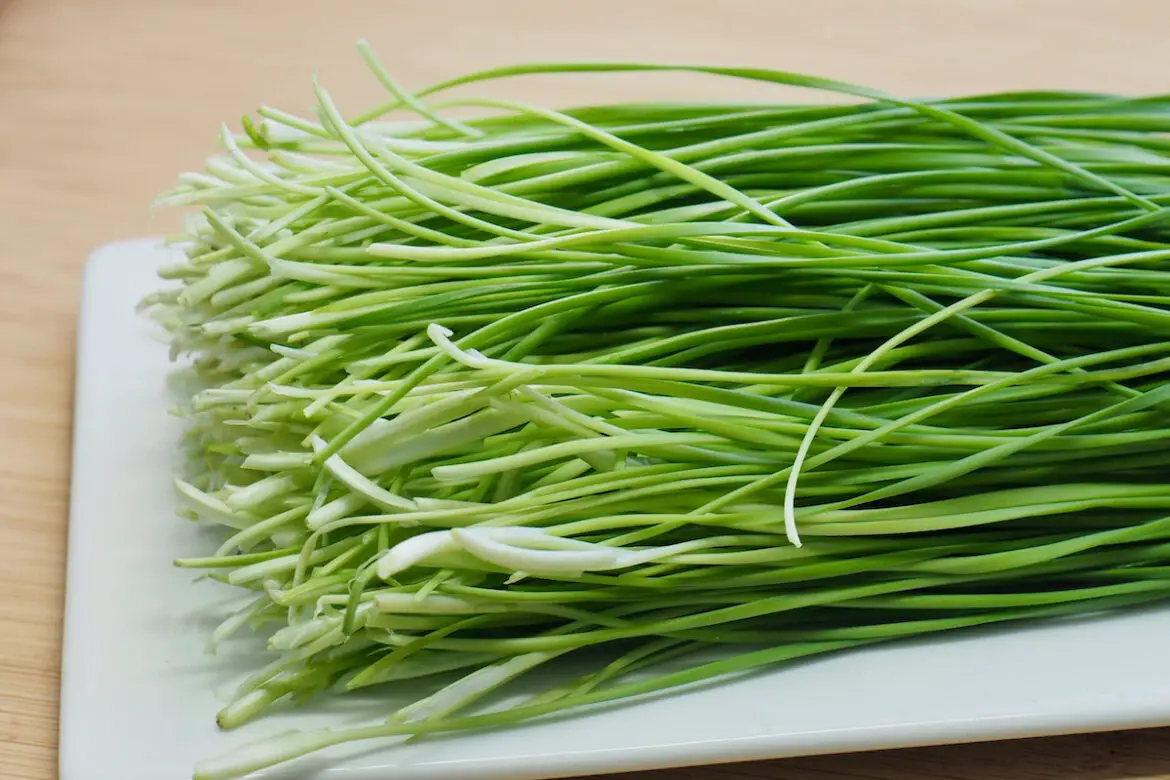This post may contain affiliate links. Please read my disclosure for details at the bottom of this page. As an Amazon Associate, I earn from qualifying purchases on this article about garlic chives in Korean cooking. I hope you enjoy learning about garlic chives, otherwise known as buchu!
What Are Garlic Chives (Buchu)?
Allium tuberosum, otherwise known as garlic chives, Oriental garlic, Asian chives, Chinese chives, and Chinese leek, is a species of clump-forming perennial plant native to the Chinese province of Shanxi. Then, over time, it became cultivated and naturalized throughout Asia and much of the world.
This late summer- to autumn-blooming plant is considered to be the garlicky cousin to common chives!
In South Korea, people refer to this plant as ‘buchu’ (부추). This ingredient is widely used in traditional and modern Korean cuisine. In the section below, I give examples of garlic chives in Korean cooking.
Note: Excitingly, you can eat the entire buchu plant! The immature flower buds, flowers, green stalks, and flat leaves are all edible.
Garlic Chives in Korean Cuisine:
As stated above, in South Korea, people refer to garlic chives as ‘buchu’ (부추). In Korea, people eat buchu by using it in fresh dishes such as namul, pickled dishes such as kimchi or jangajji, and fried dishes such as jeon. Further, they use it as a garnish or herb in soups and stews.
Below, I list a few well-known ways people use this ingredient:
- Buchu Kimchi (부추김): Garlic chive kimchi
- Buchujeon (부추전): Garlic chive savory pancakes
- Gukbap (국밥): This generic term refers to a hot soup with rice. Often, garlic chives are added as a garnish over hot soups and stews.
Garlic chives are one of the most common ingredients used in Korean cooking. The three examples above don’t even scratch the surface.

Garlic Chives Frequently Asked Questions:
Now that we learned about buchu in Korean cuisine, I want to answer some questions you may have about this ingredient! If I do not answer your question, feel free to leave a comment in the section below or email me at [email protected].
What Does Buchu Taste Like?
Garlic chives have a powerfully pungent ‘garlicky’ flavor, hence where the name comes from!
Where Can I Buy This Ingredient?
While you can sometimes buy this ingredient at your local farmers market or well-stocked grocery store, your best bet in finding this ingredient is at your local Asian market or grocery store.
How Do I Properly Store This Ingredient?
Fresh buchu have a short lifespan and should be used right away. If you cannot use it right away, cook with this ingredient within 1-2 days of buying. Until then, store the chives in the refrigerator in a plastic bag.
What Is a Garlic Chive Substitute?
If you cannot find garlic chives, I recommend using replacements such as:
- Green Onion/Scallions
- Leeks
- Shallots
- Onions; Or
- Garlic
While these options give similar flavor profiles, they do not have the same look or texture. So, you can use these if you are making a dish in which garlic chives are just one of many ingredients.
To me, garlic tastes the most similar, while green onions have the closest texture.
I Hope You Enjoyed Learning About Garlic Chives (Buchu)!
In the end, I hope you enjoyed learning about the uses of buchu in Korean cuisine. If so, let me know in the comment section!
If you would like to read more about cooking, you can find recipes as well as further Korean ingredient articles on my blog. I listed some of our favorite Carving A Journey Korean recipes below! For reference, many recipes are influenced by my family’s blended Korean and Southern heritage.
Korean Ingredient Articles:
- Korean Radish (Mu)
- Abalone (Jeonbok)
- Hot Mustard in Korean Cooking (Gyeoja)
- Nuruk (Traditional Korean Starter Culture); And
- Korean Green Plum Extract (Maesil Cheong)
Further Carving A Journey Recipes:
- Korean Acorn Jelly Salad (Dotorimuk-Muchim)
- Korean Acorn Jelly (Dotorimuk)
- Korean Plum Tea (Maesil Cha)
- Korean Sausage Stir fry (Sausage Yachae Bokkeum)
- Korean Watercress Salad (Minari Muchim)
If you have any questions or comments, you can also email me at [email protected].
And, finally, I would love to hear from you through social media as well! You can follow me at @carvingajourney on Instagram, Facebook, and Pinterest. I also started a vlog Youtube channel! Or, if you would like more articles like these, you can subscribe to my blog by joining the mailing list. Let me know if you try cooking with garlic chives (buchu)! Thank you so much for stopping by!
Carving A Journey is a participant in the Amazon Services LLC Associates Program, an affiliate advertising program designed to provide a means for sites to earn advertising fees by advertising and linking to Amazon.com. Although we may earn commissions for our endorsement, recommendation, testimonial, and/or link to any products or services from this website, these opinions are my own and I fully support these products.

